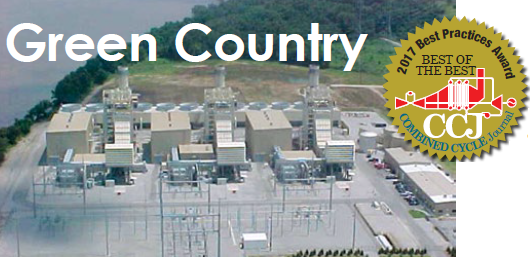Recovering ‘non-recoverable’ megawatts

Under its capacity agreement, Green Country Energy, Jenks, Okla, is incented to maximize capacity up to 795 MW, corrected to contract conditions. When new and clean, the facility was capable of producing the 795 MW from its three 1 × 1 F-class combined cycles, but after several years, capacity had declined by approximately 20 MW, depending on ambient conditions. The reason: Normal degradation of the gas turbine (GT), steam turbine (ST), and heat-recovery steam generator (HRSG).
Plant owner J-Power USA and its operator, NAES Corp, teamed up to find a cost-effective way to recover the lost megawatts. Several possibilities were evaluated within the time constraints imposed by equipment suppliers offering discounts for quick decision-making, including the following options:
1. GT advanced gas-path technology.
2. GT combustion-air enhancements.
3. GE’s OpFlex model-based control system upgrade package.
4. Increased duct-firing.
The Green Country team (sidebar) weighed these options in terms of five criteria:
- Financial.
- Environmental impact.
- Contracts evaluation, including the project’s contractual service agreement (CSA) with the OEM.
- Technical feasibility study, including input from an engineering firm and the HRSG manufacturer.
- Operations and maintenance impact study, to consider future O&M benefits and risks.
Options 3 and 4 were selected by the evaluation team. The OpFlex control system plus additional duct-burner equipment and a modified permit to increase heat input.
The OpFlex upgrade consists of an advanced model-based control (MBC) software platform that increases GT output, efficiency, and flexibility (figure). OpFlex removed the legacy control methods— exhaust temperature control, for example—and replaced them with a more flexible solution, one offering greater capability to optimize performance.

It identifies operational parameters such as exhaust temperature, firing temperature, and emissions and creates specific control loops for each parameter to ensure that the turbine as a whole is always operating within the intended design space.
Among the OpFlex offerings, Green Country selected peak fire, cold-day performance, AutoTune, and enhanced alarm help. With OpFlex installed, operators can select a megawatt value above base load—up to 100% peak-fire capability. However, once peak fire is enabled, an increased hot-gas-path (HGP) maintenance factor is incurred.
AutoTune removes the combustion restrictions of the legacy control system that limited baseload output in cold ambient conditions, providing cold-day performance increases in GT output. AutoTune also provides constant tuning of NOx and combustion dynamics, reducing the need to perform seasonal tuning. Cold-day performance requires no operator action, and it incurs no increase in the HGP maintenance factor.
Green Country also installed enhanced GT transition pieces, flow sleeves, and Stage 1 buckets to minimize the effects of peak fire on GT maintenance intervals. The evaluation team expected a capacity increase for the facility of about 17.5 MW, as well as an improved combined-cycle heat rate.
As mentioned earlier, duct-burner hardware and controls also were added to enable increased duct-firing. This included addition of one burner element, four baffles, and upgraded pressure-reducing stations to each HRSG. These additions were projected to yield up to 3 MW more output per unit, or 9 MW total for the three-unit facility.
There were some concerns about deploying the peak-fire provisions in concert with the additional heat input from the duct-burner modifications, so the potential risks were evaluated:
- The HRSG components could reach metallurgical temperature limits when both systems were fully deployed, especially during summertime ambient temperatures.
- The additional burner element and related baffles could increase the HRSG pressure drop, which would negatively impact GT exhaust pressure, especially when deploying OpFlex cold-day performance during the winter months.
- Existing equipment might not provide sufficient desuperheating capability to adequately control HP steam temperatures during the summer.
- Relief-valve capacity (with required margins) might not be sufficient to respond to a baseload trip during deployment of both peak fire and maximum duct-burner heat input.
After weighing the risks and benefits, the evaluation team determined that GE OpFlex together with the duct-burner modifications would provide a technically sound solution with limited commercial and technical risk. An overall increase of 17 to 20 MW was believed possible, depending on ambient conditions.
Success! The OpFlex and duct-burner projects met or exceeded expectations. Once the permitting requirements were finalized and the projects commissioned, Green Country conducted a capacity test that measured 801 MW. This achieved the maximum contract capacity of 795 MW with some margin.
In addition to restoring the megawatts lost through equipment degradation, the upgrades improved combined-cycle heat rate. Plus, the higher GT output and greater mass flow through the HRSG produced by OpFlex at both high and low ambient temperatures reduced the amount of duct-burner output needed to meet the plant’s normal deployment, resulting in fuel savings. CCJ
Green Country evaluation team
J-Power USA
Paul Peterson, VP of asset management
Masaru Sakai, VP of engineering
Justin Sperrazza, assistant director of asset management
Makoto Kaneko, assistant director of engineering
NAES Corp
Rick Shackelford, operations director
Danny Parish, plant manager
Michael Anderson, maintenance manager
Daniel Barbee, contracts administrator
Greg Holler, compliance supervisor
Derek Hale, lead operator



